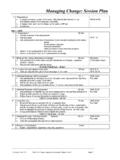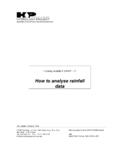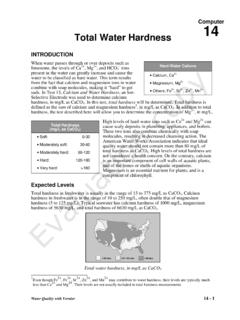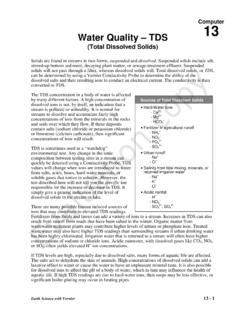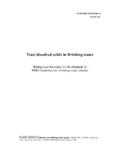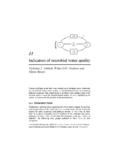Transcription of How to measure total dissolved, total suspended …
1 World Bank & Government of The Netherlands fundedTraining module # WQ - 10 How to measure dissolved , suspended & total solidsNew Delhi, May 1999 CSMRS Building, 4th Floor, Olof Palme Marg, Hauz Khas,New Delhi 11 00 16 IndiaTel: 68 61 681 / 84 Fax: (+ 91 11) 68 61 685E-Mail: Consultants BV & DELFT HYDRAULICS withHALCROW, TAHAL, CES, ORG & JPSHP Training Module File: 10 How to measure Version 05/11/02 Page 1 Table of contents1 Module context22 Module profile33 Session plan44 Overhead/flipchart master55 Evaluation sheets176 Handout197 Additional handout238 Main text24HP Training Module File: 10 How to measure Version 05/11/02 Page 21. Module contextThis module describes a laboratory exercise for measurement of dissolved , suspended andtotal solids in water samples. Modules in which prior training is required to complete thismodule successfully and other available, related modules in this category are listed in thetable designing a training course, the relationship between this module and the others, wouldbe maintained by keeping them close together in the syllabus and place them in a logicalsequence.
2 The actual selection of the topics and the depth of training would, of course,depend on the training needs of the participants, their knowledge level and skillsperformance upon the start of the titleCodeObjectives1 Basic water quality conceptsWQ- 01 Discuss the common water qualityparameters List important water quality issues2 The need for good laboratorypracticeWQ- 03 Apply the adopted standardpractices in laboratory operations3 How to prepare standardsolutionsWQ- 04 Select different types of glassware Use an analytical balance andmaintain it. Prepare standard solutions4 How to measure colour,odour and temperatureWQ- 05 measure natural colours in watersamples Distinguish different types of odoursHP Training Module File: 10 How to measure Version 05/11/02 Page 32. Module profileTitle:How to measure dissolved , suspended and total solidsTarget group:HIS function(s): Q1, Q2, Q3, Q5 Duration:One session of 180 minObjectives:After the training the participants will be able to: Determine various forms of solids in water samples Select the right size of sample used for determinationKey concepts: Gravimetric measurements Sample sizeTraining methods:Explanation, laboratory exerciseTraining toolsrequired: Board Support of a basic chemical laboratoryHandouts:As provided in this moduleFurther readingand references: Standard Methods: for the Examination of Water andWastewater, APHA, AWWA, WEF/1995.
3 APHAP ublication Chemistry for Environmental Engineering, Sawyer, McCarty and Parkin. McGraw-Hill, 1994HP Training Module File: 10 How to measure Version 05/11/02 Page 43. Session planNoActivitiesTimeTools1 Preparations Collect necessary glassware for thelaboratory exercise according to the threeSAPs for the determination of dissolved , suspended and total solids. Ensure that therequired oven and water bath is at therequired temperature. Prepare filter paper and evaporating dishesfor the use of the class by washing, dryingand cooling as described in the SAPs. Prepare sample for analysis in the exerciseby adding 1 g CaCO3 in one 1L tap water2 Introduction: Ask participants to describe different types ofsolids in water. Add / supplement to the information5 minBoardOHS3 Demonstration Allow participants time to read the 3 SAPs. Clarify doubts, if any. Ensure that each participant knows operationof the analytical balance.
4 Demonstrate the procedure to measuredissolved suspended & total minFiltrationassembly4 Practice Describe the exercise. Form working groups of two persons each. Inform the class that the first step of washingdrying and cooling of filter papers andevaporating dishes was carried out beforehand. Ask participants to write their report140 min5 Conclusion Discuss results and minBoardHP Training Module File: 10 How to measure Version 05/11/02 Page 54. Overhead/flipchart mastersOHS format guidelinesType of textStyleSettingHeadings:OHS-TitleArial 30-36, Bold with bottom border line (not:underline)Text:OHS-lev1 OHS-lev2 Arial 26,Arial 24, with indentmaximum two levels onlyCase:Sentence case. Avoid full text in :Use occasionally and in a consistent wayListings:OHS-lev1 OHS-lev1-NumberedBig for definite series of steps. Avoidroman numbers and :None, as these get lost in photocopying andsome colours do not reproduce at of a table will ease alignment over morelines (rows and columns)Use equation editor for advanced formattingonlyHP Training Module File: 10 How to measure Version 05/11/02 Page 6 How to determine concentration of solids1.
5 Measurement of total dissolved solids:50 ml aliquot2. Measurement of total suspended solids:50 & 10 ml aliquots3. Measurement of total solids:50 ml aliquotHydrology Project Training Module File: 10 How to measure Version 05/11/02 Page 71. Measurement of total dissolved solids:procedure1. Wash filter paper2. Dry evaporating dish & weigh3. Stir sample4. Pipette 50 ml while stirring5. Filter and wash three times6. Transfer filtrate to evaporating dish & dry7. Cool & weigh8. Calculate in mg/ LHydrology Project Training Module File: 10 How to measure Version 05/11/02 Page 8 Calculating total dissolved solids concentration:samplemL1000B)(ASolids/LDi ssolvedmg =where:A = weight of dried residue + dish, mgB = weight of dish, Project Training Module File: 10 How to measure Version 05/11/02 Page 92. Measurement of total suspended solids:procedure1.
6 Wash filter paper & dry2. Cool & weigh filter paper3. Assemble filtration apparatus4. Wet filter paper with distilled water5. Stir sample6. Pipette 50ml while stirring7. Filter and wash three times8. Transfer filter to evaporating dish & dry9. Cool & weigh10. Calculate in mg/ L11. Repeat steps 1 to 10 using 10 ml aliquotHydrology Project Training Module File: 10 How to measure Version 05/11/02 Page 10 Calculating total suspended solidsconcentration:samplemL1000B)-(AL/S olidsSuspendedmg =where:A = weight of filter + dried residue, mgB = weight of filter, mgHydrology Project Training Module File: 10 How to measure Version 05/11/02 Page 113. Measurement of total solids: procedure1. Weigh evaporating dish2. Stir sample3. Pipette 50ml into evaporating dish & dry4. Cool & weigh evaporating dish5. Calculate in mg/ LHydrology Project Training Module File: 10 How to measure Version 05/11/02 Page 12 Calculating total solids concentration:samplemL1000B)(A/LSolidsTo talmg =where:A = weight of dish + residue, mgB = weight of dish, mgHydrology Project Training Module File: 10 How to measure Version 05/11/02 Page 13 Exercise: Work in pairs Filter paper & evaporating dishes already washed, dried &cooled measure in sample1.
7 total dissolved solid concentration2. total suspended solid concentration3. total solid concentration Record findings Calculate ReportHydrology Project Training Module File: 10 How to measure Version 05/11/02 Page 14 Exercise: record findingsDetermineSamplevolume, mL (V)Final weight,g (A)Initial weightg (B)Concentrationmg/L50 TSS10 TDS50TS50 Hydrology Project Training Module File: 10 How to measure Version 05/11/02 Page 15 Exercise: calculate1. Add total suspended & total dissolved fractions to make massbalance for total Compare with the total solids determined Calculate percent Calculate twice; with results of suspended solids- using 50 mL aliquot- using 10 mL aliquotHydrology Project Training Module File: 10 How to measure Version 05/11/02 Page 16 Exercise: Report Reasons for different results Effect of sample Training Module File: 10 How to measure Version 05/11/02 Page 175.
8 EvaluationHP Training Module File: 10 How to measure Version 05/11/02 Page 18HP Training Module File: 10 How to measure Version 05/11/02 Page 196. HandoutsHP Training Module File: 10 How to measure Version 05/11/02 Page 20 How to determine concentration of solids1. Measurement of total dissolved solids: 50 ml aliquot2. Measurement of total suspended solids: 50 & 10 ml aliquots3. Measurement of total solids: 50 ml aliquot1. Measurement of total dissolved solids (TDS): procedure1. Wash filter paper2. Dry evaporating dish & weigh3. Stir sample4. Pipette 50ml into filter while stirring5. Filter and wash three times6. Transfer filtrate to evaporating dish & dry7. Cool & weigh8. Calculate in mg/ LCalculating total dissolved solids (TDS) concentration:samplemL1000B)(ASolids/LDi ssolvedmg =where:A=weight of dried residue + dish, mgB=weight of dish, Measurement of total suspended solids (TSS): procedure1.
9 Wash filter paper & dry2. Cool & weigh filter paper3. Assemble filtration apparatus4. Wet filter paper with distilled water5. Stir sample6. Pipette 50ml into filter while stirring7. Filter and wash three times8. Transfer filtrate to evaporating dish & dry9. Cool & weigh10. Calculate in mg/ L11. Repeat steps 1 to 10 using 10 ml aliquotCalculating total suspended solids (TSS) concentration:samplemL1000B)-(AL/SolidsS uspendedmg =where:A=weight of filter + dried residue, mgB =weight of filter, mgHP Training Module File: 10 How to measure Version 05/11/02 Page 213. Measurement of total solids (TS): procedure1. Weigh evaporating dish2. Stir sample3. Pipette 50ml into evaporating dish & dry4. Cool & weigh evaporating dish5. Calculate in mg/ LCalculating total solids (TS) concentration:samplemL1000B)(A/LSolidsTo talmg =where:A =weight of dish + residue, mgB =weight of dish, mgExercise: Work in pairs Filter paper & evaporating dishes already washed, dried & cooled measure in sample1.
10 total dissolved solid content2. total suspended solid content3. total solid content Record findings Calculate ReportRecord findingsDetermineSample volume,mL (V)Final weight,g (A)Initial weightg (B)Concentrationmg/L50 TSS10 TDS50TS50 Calculate Add total suspended & total dissolved fractions to make mass balance for totalsolids. Compare with the total solids determined experimentally. Calculate percent error. Calculate twice; with results of suspended solids- using 50 mL aliquot- using 10 mL aliquotHP Training Module File: 10 How to measure Version 05/11/02 Page 22 Report Reasons for different results Effect of sample Training Module File: 10 How to measure Version 05/11/02 Page 237. Additional handoutsThese handouts are distributed during delivery and contain test questions, answers toquestions, special worksheets, optional information, and other matters you would not like tobe seen in the regular is a good practice to pre-punch these additional handouts, so the participants can easilyinsert them in the main handout Training Module File: 10 How to measure Version 05/11/02 Page 248.





